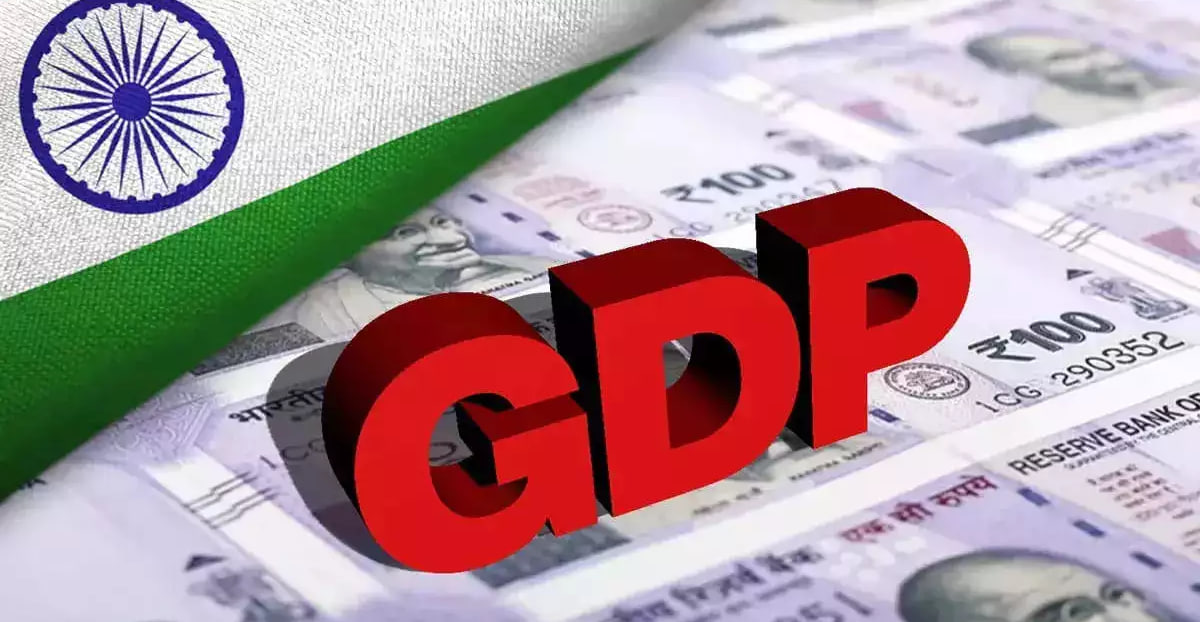
Copyright infringement not intended
Context: The Indian economy showed strong signs of recovery in the last quarter of 2022-23, registering a growth rate of 6.1% in GDP, according to the latest data released by the government. This was higher than the market expectations and also revised the full-year growth estimate to 7.2%, which is remarkable given the impact of the Covid-19 pandemic.
Details
- The GDP Growth rate remains higher than market expectations, however, the stock market did not react positively to this news, as the Sensex dropped by 0.3% or 193 points on Thursday. The main reasons for this were the global uncertainties and risks arising from the ongoing war in Ukraine, the inflationary pressures and slowdown in major economies like China and the US, and the looming threat of a debt default by the US government if it fails to raise its borrowing limit.
- Despite these challenges, many analysts and experts believe that the Indian economy is resilient and well-positioned to achieve higher growth in the coming months, as the vaccination drive progresses and consumer demand picks up.
- They also advise investors to stay invested in the stock market, as the valuations are reasonable and there is potential for new highs in the near future.
The possible factors for the increase in GDP growth rate
The Rising US Debt
- The US is the world's largest economy and a major trading partner for India. However, the US is also facing a huge debt burden, which has increased significantly due to the pandemic-induced stimulus measures.
- This high level of debt poses several risks for the US economy, such as higher interest rates, lower credit ratings, reduced fiscal space, and lower growth prospects.
How does this affect India?
- One possible outcome is that the US dollar will depreciate against other currencies, including the Indian rupee. This will make Indian exports more competitive in the global market, especially in sectors like IT services, pharmaceuticals, textiles, and engineering goods.
- A weaker dollar will also reduce the cost of imports for India, such as oil and gold, which will ease inflationary pressures and improve the current account balance.
- A depreciating dollar will increase the attractiveness of emerging markets like India for foreign investors, who will seek higher returns in other currencies.
- The US faces higher inflation due to the excess liquidity in the economy. This will force the US Federal Reserve to raise interest rates sooner than expected, which will tighten the global financial conditions and increase volatility in the capital markets. This may create some challenges for India in terms of managing its external debt and foreign exchange reserves. However, India has some advantages that can help it cope with this scenario.
- India has a relatively low external debt-to-GDP ratio of about 21%, which is much lower than other emerging markets like Brazil (43%), Turkey (62%), and South Africa (72%).
- India has a comfortable level of foreign exchange reserves of $633 billion as of August 2021, which can cover more than 18 months of imports.
- India has a strong domestic demand that can cushion the impact of external shocks on its growth.
Declining Factory Activity in China
- China is another major economy and a key trading partner for India. However, China is also facing some challenges in its manufacturing sector, which accounts for about 30% of its GDP.
- Factory activity in China has been slowing down due to various factors, such as supply chain disruptions, power shortages, environmental regulations, labour shortages, and geopolitical tensions
How does this affect India?
- One possible outcome is that China will lose its competitive edge in some of the global markets, where it faces competition from other countries like India. This will create an opportunity for India to increase its market share and exports in sectors like electronics, chemicals, machinery, and automobiles.
- India can also leverage its strengths in digital technologies and services to offer value-added solutions to global customers.
- A slowdown in China's manufacturing sector will also reduce its demand for commodities like iron ore, copper, and coal, which will lower their prices and benefit India as an importer.
- Another possible outcome is that China will try to stimulate its economy by increasing its infrastructure spending and boosting its domestic consumption. This will increase its demand for imports from other countries, including India.
- India can benefit from this by expanding its trade ties with China and diversifying its export basket to include more consumer goods and services.
- India can also attract more foreign direct investment (FDI) from China by improving its business environment and easing regulatory barriers. A stronger economic relationship with China will also enhance mutual trust and cooperation between the two countries on regional and global issues.
Foreign Portfolio Investment Flows into India
- Foreign portfolio investment (FPI) refers to the investment by foreign investors in Indian securities such as stocks, bonds, and derivatives.
- FPI flows are an important source of capital for Indian companies and a key indicator of investor sentiment towards India.
- FPI flows into India have been strong and consistent in recent months, reflecting the confidence of foreign investors in India's growth potential and stability.
- According to data from NSDL, FPI flows into Indian equity markets reached a nine-month high of Rs 48,330 crore (around $6.5 billion) in May 2023.
Some of the factors that have contributed to the robust FPI flows into India are:
- The recovery of the Indian economy from the impact of the COVID-19 pandemic is supported by the vaccination drive and policy measures.
- The resilience of the Indian corporate sector has shown improved earnings and profitability in the fourth quarter of fiscal year 2022-23.
- The attractiveness of the Indian equity market, which offers a favourable valuation compared to other emerging markets and a diversified exposure to various sectors and themes.
- The stability of the Indian rupee, which has appreciated against the US dollar and other major currencies in 2023, reduces the currency risk for foreign investors.
- The easing of global liquidity conditions, which have increased the availability of funds for emerging markets like India.
FPI flows into India are expected to remain positive in the coming months, as India continues to offer a compelling investment opportunity for foreign investors. However, some risks and challenges remain, such as the possibility of a third wave of COVID-19 infections, rising inflationary pressures, geopolitical tensions, and changes in global monetary policy. Therefore, India needs to maintain its macroeconomic stability, structural reforms, and policy predictability to sustain the FPI inflows and enhance its growth prospects.
Must Read Articles:
GDP: https://www.iasgyan.in/daily-current-affairs/gdp-44#:~:text=Nominal%20GDP%20or%20GDP%20at,nt%20in%20Q1%202021%2D22.
Foreign Portfolio Investment: https://www.iasgyan.in/daily-current-affairs/foreign-portfolio-investment-26
|
PRACTICE QUESTION
Q. How has Foreign Portfolio Investment (FPI) contributed to the growth and development of the Indian economy and what are the main challenges and opportunities for enhancing its role in the future?
|

https://indianexpress.com/article/explained/explained-economics/india-gdp-growth-estimated-to-cross-7-per-cent-whats-in-it-for-the-markets-8641516/




